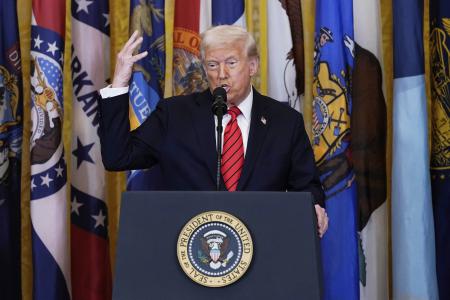
- ARAB NEWS
- 29 Jun 2025

TOKYO: Under a best-case scenario, the tariffs imposed by US President Donald Trump may allow marginal world GDP growth in the next couple of years but would leave the global economy somewhat weaker, according to estimates by economic analyst Oxford Economics (OE).
OE predicts the worst-case scenario would see significantly weaker growth than in its baseline estimate, while the upsides to growth for many countries in its best-case scenario would be modest at best.
In OE’s worst-case scenario, the Trump administration would push ahead with higher country-specific reciprocal tariffs, which would hit demand and unleash supply-chain stress in the US and beyond.
The hardest-hit countries would be those that export a large share of their goods to the US, such as Canada, Mexico and Vietnam, as well as the US itself.
OE concludes, “There are no absolute winners from bigger tariff hikes.”
The worst-case scenario also sees job losses increasing significantly in the world’s advanced economies and a reduction of consumer spending.
Firms are likely to scale back investment plans even more sharply, resulting in a fall in investment. Trade volumes would also likely decrease substantially.
While OE’s baseline forecast sees tariff hikes acting as a disinflationary impetus outside the US, its worst-case scenario assumes that retaliatory tariffs would hit supply chains. Inflation would increase, limiting the extent to which central banks can cut rates to support growth.
In OE’s best-case scenario, 10 percent tariffs would remain in place across much of the world, with some exemptions and the removal of some of the universal sector-specific tariffs.
Although this would boost world GDP growth relative to OE’sMay baseline by 0.1ppt in 2025 and by 0.3ppts in 2026, it would leave the global economy in a somewhat weaker state than expected before the tariffs were introduced.
In OE’s worst-case scenario, the world economy would edge closer to a recession, with the costs being distributed unevenly. “There will be no absolute winners at an economy-wide level,” OE states.
OEs May forecast assumes that most economies will be subject to a tariff of around 10 percent, resulting in the trade growth slowing significantly this year and next. However, in the best-case scenario, reciprocal tariffs would be diluted by widespread exemptions.
OE concludes: “Our modelling suggests that, under the worst-case scenario, the US economy enters a recession in H2 2025, leaving GDP around 6% below our baseline forecast by the end of 2026. This is roughly treble the size of the GDP hit that the world suffers.”
“Economies with a relatively high export share to the US, such as Canada, Mexico, and Vietnam, also fare relatively badly. Conversely, China experiences a smaller hit to its GDP under this scenario. The inflationary impact is the largest in the US and in its key trading partners over the medium term.”